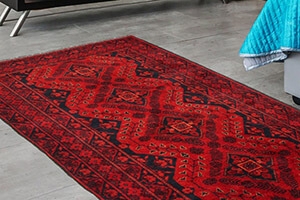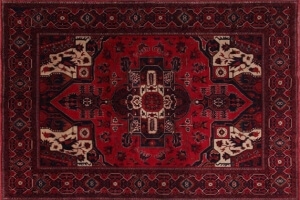What do we know about the Afghan carpet?

The Making of Afghan Carpets!
Afghan carpet is a type of handmade textile which is traditionally made in Afghanistan. Afghan carpets have won several international awards at the annual international Domotex exhibition in Hannover, Germany. Afghan carpets are made by different ethnic groups in Afghanistan. Mostly Turkmen Afghans make carpets in the North and West of Afghanistan (Aqcha, Mazar-e Sharif, Herat). One of the most exotic and distinctive of the eastern carpets is Khalmohamadi or Aqcha ( Aqcha is an Afghan city), knotted in the Balkh province of northern Afghanistan. The carpet is available throughout Afghanistan, with most of it being available in Mazar-e Sharif. The founders of Carpetdepo are also from this city. Another typical carpet of Afghanistan is the Baluchi carpet. These are made by the Baluchis of Afghanistan in the southwest of the country.
Various natural colours from plants are used to produce the beautiful warm colours. A wide variety of patterns and colours are used, but the traditional and most typical is the octagonal elephant foot pattern, often with a red background. The elephant's foot pattern dates back nearly 1000 years. Other accessories for the nomadic lifestyle, such as tent bags, wall coverings, coasters and saddle bags, are also produced by carpet makers.
Khal Mohammadi carpets
Khal Mohammadi carpets are unique because of their colour combination, named after a gentleman named Khal Mohammad who lived in Afghanistan when he created this type of carpet with a special colour scheme.
These carpets are pleasant, friendly and warm in colour. They are usually deep red, light blue or black. They take their name from their colour, for it was Khal Mohammad who developed the red tones for these carpets. The pattern of the carpet is variable but is mainly characterised by the Bokhara and other patterns adapted from the Turkmen heritage.
Beljik oriental carpets

Beljik oriental carpets are made in northern Afghanistan, a Turkmen ethnic area inhabited by urban and rural people
This type of wool carpets are made in the northern part of Afghanistan, in an area inhabited by Turkmen ethnic groups, both urban and rural. They are one of the best Afghan carpets.
They add a unique atmosphere to our homes with their varied of designs and colours. They are very dense and are knotted from the finest fine wool, making them very shiny and changing colour on all sides in a similar way to silk carpets.
This type of Persian carpet are called Beljik because their New Zealand wool base is imported from Belgium to Afghanistan after the yarn is made. Because the yarns came from Belgium, the makers called it Beljik (Beljik, Beljik), but it is actually a type of Khalmohammadi type carpet made from the finest wool in a dense knot.
Khal Mohammad is the name of an Afghan gentleman. He also invented the colour of the Belshik type of carpet. This wool carpet is washed and sun-dried four times after making and shearing and is also colourfast. Many people believe that the denser and thicker the Persian carpet, the better and more durable it is. Thickness is a matter of shearing. Durability is the result of the density of the knotting and the quality of the material.
Manufacture: handmade
Knot count: approx. 450 000 knots/m2
Place of origin: Afghanistan
Knotted part material: 100 % wool
Warp yarn material: 100 % wool
Thickness: approx. 6-7 mm
Child labour in the making of the Oriental carpet!?
According to a report by the US Department of Employment and Labour, Afghanistan is one of 74 countries where significant child labour has been found in the production of carpets. This is wrong!!!! Oriental carpets can only be made by craftsmen, which requires a lot of patience. Teenage children do their part in making carpets, but not nearly as much as you might think from thousands of miles away. All the members of families who have lost their breadwinners in the war are forced to work because of the abject poverty. So even the children go out to work, or worse, beg on the streets. This does not mean that they are enslaved. Especially since most of the Afghan carpets are knotted in their own homes. So families are provided with the yarn for the loom, the pattern for the carpet and other tools to knot the carpet in their own homes. They are the ones who do the knotting or weaving. The children help them with this. Nomadic carpet do not have a large manufactory with a many workers in one place. This information I have shared with you, I know exactly how it is. I have seen it and I can see it with my own eyes. That is why it is disgusting when a nation is stigmatised with false labels. In wartime, most Afghan carpets are sent to Pakistan, where they are unfortunately labelled 'Made in Pakistan', even though they are made in Afghanistan. As no country has a trade agreement with Afghanistan. There are not many opportunities in Afghanistan, but carpet manufacturing can remain a strong pillar of the outcrop handicraft. When you place a handmade carpet in your home, think about how much work goes into it and how many families' livelihoods it provides. Our carpets are made with love for our prospective customers. Take a look around at www.carpetdepo.eu. I am sure you will find the carpet that is closest to you.
